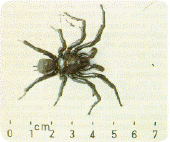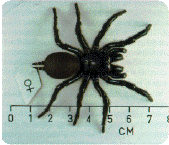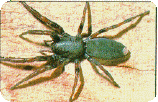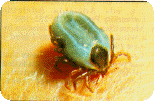Australian Spider and Insect Bites PLEASE NOTE: - this page is no longer actively maintained. The information provided may not reflect current treatment guidelines. Of all the thousands of Australian spiders, arthropods and insects, only three have bites which alone are capable of causing death - the funnel-web spider (and related atrax species), the red back spider and the paralysis tick. In most other spider or insect bites, rest and elevation, local application of ice packs and lotions, simple analgesics and antihistamines are all that is required. Anaphylactic reactions may occur after insect bites, and these may be life threatening. Welton noted that death following spider bite in Australia happens less than once per 10 years, whereas death from anaphyloaxis following bee, wasp, hornet, tick or ant bite is as common as death from snake bite (2/year). Please do not contact me for information on the management of spider infestations or for help with identification of a particular spider. Some other nice photos can be found on on Steves Aussie Spider Pics. Detailed information with pictures is also available from toxinology.com - click on spiders and select australia as the country. I have medical treatment information information for bites or envenomation from the following: The Sydney funnel web (and a few related Atrax species) is unquestionably the most dangerous spider in Australia; the red back and the paralysis tick are the only other two arachnids with potentially fatal bites. Geoff Isbister has authored a nice review of the management of spider bites on the Australian Prescriber website. The AVRU has a page on spiders with some nice photos and a description of their behaviour. The Australian Reptile Park pioneered funnel web venom milking and is the sole supplier of venom to CSL for antivenom production, and they now have a specific spider exhibit. If you capture a live funnel web please take it to one of their funnel-web collection points. Their comprehensive information about important Australian spiders makes fascinating reading. Wikipedia has a lot of info too. See also the Australian Resuscitation Council guidelines on spider bite. Sydney Funnel Web (Atrax robustus)
This is one mother of a spider! It is a large (6-7 cm), black, aggressive, ugly looking spider with massive fangs. These are large and powerful enough to easily penetrate a fingernail. When disturbed it tends to rear up on its hind legs, a defensive posture that exposes the fangs. They can lunge forward abruptly, and are said to be incapable of jumping, however this anecdotal report from a reader suggests otherwise: "We live in a pocket of rainforest on the Central Coast of NSW and unfortunately have had several first hand encounters with funnel webs spiders. In one instance we were chasing an antechinus [a small native mouse-like mammal] to get it out of the house, unaware that it was chasing after a funnel web spider which was on the floor. The spider (which we hadn't seen) was disturbed and jumped straight up into the air at least 1/2 a metre high, possibly more." During a bite the spider firmly grips its victim and bites repeatedly; in most cases the experience is horrific. The venom is highly toxic. Before an effective antivenom was developed, severe envenomation could be fatal. The Sydney funnel web spider is mostly found near Sydney (from Newastle to Nowra and as far west as Lithgow but sightings have been reported as far north as Brisbane. Related species are found along the eastern coast of New South Wales. The venom of the slightly smaller male spider is five times as toxic as the female. This is unfortunate, as male funnel webs tend to roam about, particularly after heavy rain in summer, and often wind up indoors. The primary toxic component is atraxotoxin, which alone can cause all the symptoms. The venom also contains hyaluronidase and other components (GABA, spermine, indole acetic acid). For some strange reason, human beings (and other primates and monkeys) are particularly sensitive to the venom, whereas toads, cats and rabbits are almost unaffected! Atraxotoxin causes acute massive release of neurotransmitters at autonomic and neuromuscular junctions with associated uncontrolled autonomic hyper-reactivity and muscle twitching, followed about 2 hours later by neurotransmitter depletion and weakness. Symptoms The bite is usually immediately painful, and if substantial envenomation occurs, symptoms commence usually within a few minutes. They include, progressively:
After about 2 hours the muscle fasiculations and most symptoms start to subside, and are replaced with insidious but profound hypotension, primarily due to severe cardiac failure. First Aid: All bites from big black spiders should be managed as suspected funnelweb bites. The pressure immobilisation technique MUST be commenced as soon as possible. Any delay risks the rapid onset of systemic symptoms. There have been no reports of deaths when effective first aid had been instituted. The patient should immediately be evacuated to a medical facility capable of managing the envenomation. Treatment will require giving antivenom, providing artificial ventilation, and invasively monitoring the patient. Bandages MUST NOT be removed prematurely. There is evidence that the venom may inactivated by prolonged localisation. Medical Management Institute intravenous access, adequate monitoring (iv, SpO2, non-invasive or arterial BP) and obtain antivenom BEFORE removing first aid bandages! An apparently well patient may suddenly deteriorate when they are removed. If nothing adverse happens within 2-4 hours of bandage removal the patient may be sent home. The moment symptoms or signs of systemic toxicity develop, the antivenom should be administered intravenously. The initial dose is two ampoules and can be repeated every 15-30 minutes. Supportive management, including oxygen, iv atropine, antihypertensives and sedation is usually required even if the antivenom is given. If the antivenom is administered early, the clinical situation is unlikely to get out of control. Management of severe envenomation involves:
The antivenom is a highly purified rabbit IgG immunoglobulin and is highly effective; it should be given as soon as signs of significant envenomation are seen. Prophylactic adrenaline is not required, nor steroids, and there have been no reports of adverse reactions following its use. Occasionally bites from the mouse spider or other atrax species may develop similar symptoms; if these are severe enough it may be useful to try funnel web antivenom. Some more pics:
More info is available from the AVRU funnel web pages, the Australian Museum, Toxinology.com and the Australian Reptile Park. Red Back (Latrodectus mactans hasselti)
Red back venom contains neurotoxins, but works very slowly. Fatalities, even from untreated bites, are rare. The bite is immediately painful; the pain may involve the whole limb. Sweating is common, starting only on the affected limb. Systemic envenomation usually results in headache, nausea, vomiting, abdominal pain, pyrexia, hypertension and in severe cases, paralysis. Untreated, the symptoms worsen over a 24 hour period and may take weeks or months to resolve. The pressure and immobilisation technique is NOT recommended as local pain may become excruciating. It may be relieved by the application of ice packs. The red back specific anti-venom is reliable and is given to around 250 cases each year. It should be withheld unless signs of systemic envenomation develop, and if none occur with 24 hours is usually not required. However, if administration is delayed, it is still effective in relieving symptoms up to 10 days after the bite. Antivenom may be given intramuscularly, because of the small volume involved. Adrenaline need not be given beforehand, unless the patient has prior exposure to equine antivenom or antitoxin or has an allergy to equine protein, in which case steroids should be given for four days as well. Another pic: Red Back Spider (31K jpeg) More info: AVRU redback pages, Australian Museum, Toxinology.com, Australian Reptile Park.
The evidence suggesting that whitel tailed spider bites cause this problem is very weak. The typical clinical picture is painful cutaneous blistering and inflammation which may progress into intensely cyanotic lesions, occasionally resulting in substantial recurrent local tissue necrosis with a deep rolled ulcer involving fat and skin and exposing muscle. Amputation has been required for severe necrosis, and ulcer recurrence may last for years. Isbister, Medical Journal of Australia, 2003 pages 199-202 surveyed 79 patients with provien white-tail bites and none developed skin necrosis, although most bites were painful, and about 1/3 developed a persistent itchy red mark for 5-12 days. When skin necrosis occurs after a presumed bite, the precise cause is unknown. It seems likely to not be due to the spider's venom. Although the recluse venom alone causes necrosis, white-tail venom has been shown to not be cytotoxic or damaging to human cell cultures, so the most likely cause is secondary infection, which may occur after any insect bite or skin abrasion. Most cases of skin necrosis have no prior history of any spider bite. Approximately 25% of cases are associated with skin cultures positive for staphlococci. Strep pyogenes or mycobacterium ulcerans have been causatively implicated, however new evidence suggests that mycobaterium ulcerans may not play a significant role in the syndrome. Treatment depends on severity. Please review the literature. If an area of redness and blistering develop, the limb should be elevated and the patient rested. No drug treatments, including antibiotics, have been clearly shown to be effective early. Blisters should be cultured before commencing antibiotics. A microbiologist needs to be involved to look for mycobacteria as well as other bacteria. Antibiotics should be administered on positive culture or on reasonable suspicion of secondary infection, however poor clinical response is to be expected. Topical antibiotic eg Bactroban covered by glad wrap to ensure prolonged contact may help. A 'control' application may be useful to exclude allergy to the topical antibiotic. Lesions ahould be carefully observed; it may be a good idea to photograph them daily, and the patients temperature and general condition should be observed and recorded. Should the situation deteriorate, the skin may start to look mottled or pale or bluish, or the redness and swelling may spread widely. This is unusual, but if it happens the patient needs admission to hospital. Ruling out serious secondary infection is advisable; this may include skin biopsy. The role of empirical antibiotic therapy is unclear. Should gangrene and/or skin necrosis occur surgical management may be appropriate, however early aggressive surgical therapy is not advocated. Hyperbaric Oxygen and Dapsone have been shown to be of benefit, mostly on data from treatment of experimental brown recluse venomation of animal models. Reader feedback includes the following: "I was bitten by some kind of spider and was watching my finger necrotising away. The medical profession was no help and eventually said they may have to take off the finger.....then i started urinating on it. Sounds gross but it worked and now my finger is almost back to normal with only some scarring. wanted to let you know in case it can help someone... thanks." [I don't have any medical reason why urine would help - Chris] "I recently received what the doctor diagnosed as a bite by a white tailed spider. The bite occurred in the crease of my arm - inner elbow - and there were two large and two small areas of necrosis like a butterfly pattern on either side of the crease. Surrounding the dead skin was an area of redness about the size of the palm of a medium adult hand. As well there were two more areas affected - a small area on the side of my arm and another nearer the arm pit. She told me that there was no cure but that anti-biotics (Keflex) would prevent bacterial infection,and that anti-histamines and cortisone cream would reduce swelling and itch. She explained that the medicine would be 'supportive' not curative. I followed her instructions and as well, with her permission, as read on your website, regularly poured my urine on the wound. The bite occurred about the 11th November and I began the treatment on the 12th. The area is healing well and appears not to be becoming ulcerative. I am sending this information in the hope that it may help others." "I had a large weeping blister getting deeper although it was relatively painless, and had already tried antibiotic ointments, betadine ointments, and daktarin anti fungal cream to rule out all possibilities. I then soaked it in Apple cider vinegar for 15 minutes. It stung unlike any other treatment, and had a positive turn around. I caught the spider which appears to be a white tip, and the bite took 2 days to fester on my knuckle, and another 2 days to worsen and deepen despite treatemnt. It is now mildly inflamed, dry and sealed and although it feels as though it ould flare underneath, it seems to be heading in the right direction. If it worsens, I will probably experiment with an extracting salve i have used in the past for splinters, adn may also massage with hirudoind to try to disperse the toxin a little. It may be worth looking at the effects of the vinegar... hope this helps!" It is probably worth discussing severe cases with the Venom Research Unit of the University of Melbourne. The AVRU site provides limited information about white tail spider bites and necrotising arachnidism. Having crossed the Tasman, the NZ Govt has this note about white-tail spiders and how they do not cause necrosis. Identifying the offending spider in presumed cases of necrotising arachnidism is near impossible unless the actual spider is caught. Convalescent serum (stored at -20C) may be tested against known spider venom components. Always try to catch the spider for identification. The AVRU has a page of photos and information and treatment for spider bites. The Australian museum has factsheets on the trapdoor, mouse, white-tail, wolf, black house, huntsman, sac, orb-weaving and other spiders as well as information about their role in the environment. Only the funnelweb and redback are known to cause death from envenomation. Other spider bites usually cause local pain, which may be relieved by ice packs or simple analgesics and antihistamines may help swelling and itching. Vague constitutional symptoms such as dizziness, headache, etc usually do not require specific treatment. The pressure-immobilisation technique is inapprqopriate for bites from spiders other than the funnel web and related atrax species. It should be applied when the spider has been clearly identified as a funnel-web, there are signs of systemic envenomation, or as a precaution when there is reasonable doubt that the spider causing the bite may have been a funnel web. The huntsman is a common large spider along the east coast of Australia. One of my favourites! I actually had a big one fall into my lap off the sun shade of my car while driving down the freeway once! They are quite harmless, though when they wander indoors or get lost inside cars it can be frightening. Don't kill them, just get them outside again. There is a report of an anaphylactic reaction to contact with a huntsman spider; the furry spines can cause itching.
Grass ticks can be a real nuisance at times, causing really itchy bites. Sometimes hundreds of small ticks can attach to a persons legs, causing significant swelling and profound itching. Sometimes these are the nymph forms. Ticks naturally grow on bandicoots, wallabies etc. Prevention is better than cure. If you know you are going into tick areas, wear long, light-coloured trousers and tuck them inside tight socks. If you look out for ticks crawling up the outside of your trouser legs you can brush them off before they get inside. Applying permethrin sprays to fabrics can repel or inhibit tick attachment. They are also useful for mosquitoes, sandflies, etc. Do a google search for online suppliers. Mammalian Meat Allergy An unusal but devastating complication of tick bites is red meat allergy. This is a cross-hypersensitivity reaction between tick saliva and AlphaGal, a protein in mammalian meat and some related milk and gelatine products, developing 2-10 days after the bite, and causing the patient to become extremely allergic to red meat. It has been suggested that prompt removal, and removal in such a way as to to minimise the amount of saliva / venom injected, may reduce the chance of subsequently developing this problem, however at present there is no data to confirm or deny that hypothesis. The tick induced allergies, research and awareness site has more information on this topic. They recommend removal of adults with ether-based freezing sprays (which would anaesthetise the tick as well as freeze it) or permethrin cream for immature ticks. For more information on treatment and management of allergic or anaphylactic tick reactions see this ASCAIA page. First Aid - tick removal Removal of the tick can be achieved in many different ways. Never grip the the sac and pull! This may squeeze more venom in, or break the body off, leaving the head and 'torso' firmly stuck, which is almost certain to get infected. The current recommendation is to grip the tick as near to the head as possible with a very pointy pair of tweezers or forceps.
These pictures from CDC illustrate the sort of tweezers to get and how to use them. This technique works best before they get really engorged. Very few people have the right kind of tweezers. Ordinary eyebrow tweezers MUST NOT BE USED because the points are too wide. You can get great fine curved tip stainless tweezers, intended for picking up tiny SMD electronic components, from EBay for $1.00 If you have tick allergy or jst need to remove a lot of them, get some - they are just brilliant for tick removal. For larger ticks I and many others quite like making a 'loop' or 'noose' from a piece of cotton thread with a single throw knot (half of a reef knot). Place this carefully at the bottom of the body, then slowly and gently close it until it won't slip over the body. Gently pull on the free ends of thread with a 'to-and-fro' rocking motion until the whole tick comes out. This technique requires skill. If you have really fine tipped tweezers, they are better. But a fine cotton noose can work well even when greatly engorged, and a thread of cotton is readily available. It does take practice - they can be well stuck. Nothing entertains children more than seeing the little wriggling legs of the removed tick - except the satisfaction of finally squishing them! Ticks usually have a firm hold on you once they have dug in. Additionally, there can be quite a lot of swelling around them. This can make them difficult to remove. See also the advice at TickAlert. Freezing or immobilising the tick before removal Many people have sought a way to induce the tick to 'let go' by themselves, or at least to cause them to 'relax their grip'. These have included putting ti-tree oil, metho, turps, kero or similar on the tick, or spraying with insecticide, or even touching the tick with a lighted match (as for leeches). Not all at the same time! Any of these are potentially hazardous to the patient because they can induce spasm in the tick and may cause it to inject more venom (as well as the possibility of skin reactions or burns). There are no scientific studies to actually test if any of these manouevers are more helpful than just pulling it out alive. The US Centres for Disease Control recommends against doing any of these things. Currently there is a strong push to use 'freezing sprays' such as Wart-Off FreezeŽ or Elastoplast Cold SprayŽ before attempting removal. Cold (enough of it) will quickly send a tick 'to sleep'. However it's not known how cold it has to get. Too much cold may cause skin damage. An ice pack very closely applied for 30 minutes may be quite good. The hope is that with cold, the tick just quietly loses interest and doesn't inject any more salival. CRC brand "Aerostart" is a mixture of gasoline (60%), ether (10-30%) and ethanol that has been recommended for freezing ticks. It is highly volatile and flammable to the point of being explosive. Take care. There is no scientific evidence to validate cold being any better or worse than any other method, but it sure sounds attractive, especially from the point of view of the suppliers of freezing sprays. I received an e-mail from a person in the US who suggested thoroughly coating the tick with vaseline for 10 minutes. Ken Markham has tried this and says that it works well so long as the tick is completely and totally covered. Even then you sometimes need to wait up to 2 hours. Ken says that sfter 30 minutes to 2 hours they just back out by themselves. If you are a patient person, and can fully coat the tick, this is probably the best option. Insects breathe by drawing air in from the sides of their bodies and can survive for a long time without any air at all, at least an hour. Sharyn Powlseland from Far North Queensland recommends avoiding physical disturbance of the tick if possible, then applying several drops of 100% Ti-Tree oil and waiting 20 minutes - or until the legs no longer wriggle once prodded - before pulling it out. Coating thickly in paw-paw ointment for an hour or so has also been effective for some people. A thick coating of an insecticide cream intended to poison scabies mites, eg Lyclear, a 5% permethrin cream, might also do the trick if left for long enough. Another reader suggests putting drops of oil on the tick, which causes it to back out quite quickly. It's hard to know if the tick would prefer to be ripped out alive or to be asphyxiated or anaesthetised first! My personal preference is to cover them in with a cotton wool ball soaked in methylated spirit (alcohol) for 15 minutes. This should gradually anaesthetise the tick and sterilises the area; I think they seem a little easier to pull out that way. If the patient has developed severe envenomation symptoms, apply the pressure and immobilisation technique until they can receive antitoxin. If there are lots of small 'grass' ticks, and there can be hundreds, just pull them out alive, as there will be too many to soak in alcohol. When they are small and have not 'dug in' too far they are easy to pull out. I remember my kids pulling out about 30 one afternoon, quite enjoying it once they got the idea. Not so nice for toddlers! 'Lyclear' is an over the counter 5% Permethrin cream scabicide that poisons ticks. Something like this could be applied for the required time and then the ticks can be much more easily removed. It is important to be sure that they actually die and are removed. It takes a long time. Watch the dose if a large area must be treated with a miticide like Lyclear. It might be a good idea to apply Lyclear to some of the ticks and wait a while to see if they are easier to remove than those left alive, and then only use it on the rest if it was beneficial. Note that permethrin is highly toxic to marine life. Any excess should be not put down the sink but exposed to full sun in a thin film or dissolved in water so it will degrade in a few hours. Malathione poisons as for head lice may be OK but could also induce spasm, like ordinary anticholinesterase based insect sprays, and generally are not recommended. I've received an e-mail from a farmer with a lot experience with bites from both paralysis and grass ticks. He has also experienced similar bites mostly around the ankles and at times over the body, without being able to discover the cause, and is wondering if ticks in their nymph stages might also be the culprit. Neil Houghton suggests that nyphs probably can bite, as they are not much different from adults, and notes that ticks and nymphs can also transmit Lyme disease from deer etc. as confirmed by this blog. Medical treatment. An effective antivenom is prepared from the serum of chronically infested dogs. This should be administered intravenously to all patients with signs of systemic envenomation. Airway support and ventilation may occasionally be required; equally rarely desensitisation of hypersensitive individuals. Sometimes a person can get covered in large numbers of tick or nymph bites and at least in some cases these can remain persistently itchy, causing lymph gland swelling and malaise for some time. It is also possible that tick nymphs could repeatedly bite a person or live in their hair like lice between bites. Severe persistant itching can be a problem especially after multiple grass tick bites. First exclude or treat infection. The itching itself can cause tissue damage and scarring; severe cases may require short-course systemic steroids to limit itching, provided infection has not occurred. Anti-histamines, calamine lotion, lignocaine ointment, bicarbonate baths and paw-paw ointment have been used with success for itching, but like sand-fly bites it can be severe and prolonged. More info? Scotland Island News have a great practical article on ticks, their life-cycle and bite minimisation strategies. There is a great deal of information at Tickalert, an excellent Australian site, ASCIA, and TIARA. Bees, wasps, ants and other arthropods These bites, no matter how painful, are only potentially lethal in patients with allergy to the venom of the insect concerned. In these patients, a bite should be considered a medical emergency. The pressure and immobilisation technique should be applied and the patient immediately brought to a hospital. Anaphylaxis should be treated promptly with adrenaline, airway support, colloids, etc. Bee stings should be scraped off, rather than pulled out, to avoid squeezing further venom from the attached sac into the patient. Ice packs applied to the bitten area may reduce local pain. If severe, antihistamines, oral analgesics, and even steroids may be required. Factsheets on other insects are also available from the Australian Museum. Information on this web page was provided by Dr. Struan K. Sutherland the Director of the Venom Research Unit of the Department of Pharmacology, University of Melbourne and from published papers. Struan has recently published a book of his memoirs titled "A Venomous Life" (available from Hyland House Publishing, 387 Clarendon Street, South Melbourne, 3205 Australia). Its a great read! Members of the public who are seeking information about how to identify and deal with spider problems in their home environment should contact their local pest inspector. Dr. Geoff Isbister has commenced an ethics-approved prospective study of the clinical effects of spider bites in NSW. This is to be carried out by the RPAH Emergency Department and the NSW Poison Information Centre (available 24 hours on 13 11 26). If you have definitely been bitten by a spider, and have actually caught and kept the it (intact), we would like to hear from you, regardless of the severity or outcome of the bite. You can either turn up to the Emergency Department of RPA or phone the NSW Poisons Information Centre. You will be required to complete a consent form to enter the study. Captured spiders should be placed intact into a sealed bottle containing methylated spirits (70% ethanol in water), and will be identified by Dr. Mike Gray of the Australian Museum. This study may soon be extended to other states, however the main contact number will remain 13 11 26. In an emergency Geoff may be contacted on his mobile (0413 653 503). Other pages of interest include my general envenomations page and my pages on Australian snake and marine envenomation. Last updated Tuesday, December 04, 2018 |
||

 Female funnelweb on the left, male on the right.
Female funnelweb on the left, male on the right.  The adult female red back is about 2-3 cm long, quite black, with a distinctive red stripe on its abdomen. The male is much smaller and considered harmless. Neither are aggessive. Here's some
The adult female red back is about 2-3 cm long, quite black, with a distinctive red stripe on its abdomen. The male is much smaller and considered harmless. Neither are aggessive. Here's some  The
The  The Australian paralysis tick (
The Australian paralysis tick (
